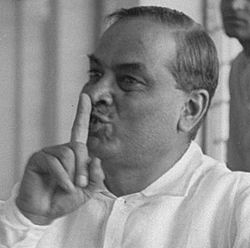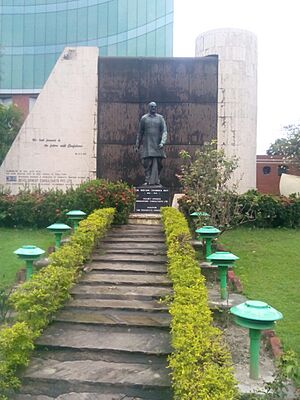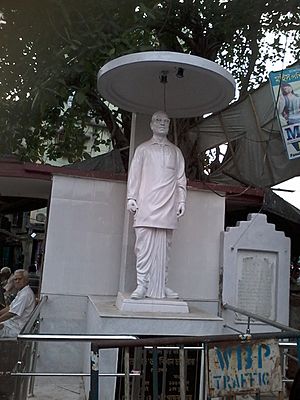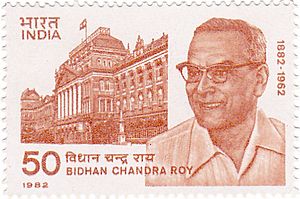Bidhan Chandra Roy facts for kids
Quick facts for kids
Dr. Bidhan Chandra Roy
MRCP, FRCS
|
|
|---|---|

Roy in 1943
|
|
| 2nd Chief Minister of West Bengal | |
| In office 23 January 1948 – 1 July 1962 |
|
| Governor | C. Rajagopalachari Kailash Nath Katju Harendra Coomar Mookerjee Phani Bhusan Chakravartti Padmaja Naidu |
| Preceded by | Prafulla Chandra Ghosh |
| Succeeded by | Prafulla Chandra Sen |
| Member of West Bengal Legislative Assembly | |
| In office 1952–1962 |
|
| Preceded by | Constituency established |
| Succeeded by | Bijoy Singh Nahar |
| Constituency | Bowbazar |
| In office 1962–1962 |
|
| Preceded by | Bijoy Singh Nahar |
| Succeeded by | Siddhartha Shankar Ray |
| Constituency | Chowranghee |
| 6th Mayor of Kolkata | |
| In office 5 April 1931 – 9 April 1933 |
|
| Preceded by | Subhas Chandra Bose |
| Succeeded by | Santosh Kumar Basu |
| Personal details | |
| Born | 1 July 1882 Bankipore, Patna Bengal Presidency, British India |
| Died | 1 July 1962 (aged 80) Kolkata, West Bengal, India |
| Political party | Indian National Congress |
| Parents | Aghore Kamini Devi Prakash Chandra Roy |
| Residences | Kolkata, West Bengal, India |
| Alma mater | Presidency College (IA) Patna University (BA) Calcutta Medical College (MBBS, MD) Royal College of Physicians (MRCP) Royal College of Surgeons (FRCS) |
| Profession | |
| Awards | Bharat Ratna (1961) |
Dr. Bidhan Chandra Roy (born on 1 July 1882 – died on 1 July 1962) was an important Indian person. He was a doctor, a teacher, and someone who loved to help others. He also fought for India's freedom and became a great leader. From 1948 until he passed away in 1962, he served as the Chief Minister of West Bengal.
Many people call Bidhan Roy the "Maker of Modern West Bengal". This is because he helped start many important schools, hospitals, and even five new cities! These cities include Durgapur, Kalyani, Bidhannagar, Ashokenagar, and Habra. He was also one of the few people in history to earn two special medical degrees, F.R.C.S. and M.R.C.P., at the same time.
In India, we celebrate National Doctors' Day every year on 1 July to remember him. In 1961, he received the Bharat Ratna, which is India's highest award for civilians.
Contents
Early Life and Education
Bidhan Chandra Roy was born on 1 July 1882 in Bankipore, Patna, Bihar. His family was Bengali Kayastha. His father, Prakash Chandra Roy, worked as an excise inspector. His mother, Aghore Kamini Devi, was a kind and religious woman who helped people in her community. Bidhan was the youngest of five children.
His parents were part of the Brahmo Samaj, a social and religious movement. They lived a simple life and used their time and money to help anyone in need, no matter their background. Bidhan's father came from a royal family, but he wasn't rich. Even so, he and Bidhan's mother supported the education of their own children and many poor orphans. They taught their children to be generous and share what they had.
Bidhan finished his early schooling in 1897. He then studied at Presidency College, Calcutta and Patna College, where he earned a degree in Mathematics. He decided to study medicine and joined the Calcutta Medical College in 1901. While studying, he found a quote that inspired him throughout his life: "Whatever thy hands findeth to do, do it with thy might." This means to do everything with all your effort.
During his college years, the partition of Bengal was announced, causing a lot of political unrest. Even though many people were joining the freedom movement, Bidhan focused on his studies. He believed he could serve his nation better by becoming a skilled doctor first.
In 1909, Bidhan went to Britain to study medicine further. He only had ₹ 1200. He wanted to join St Bartholomew's Hospital, but the Dean didn't want to accept an Asian student. Bidhan didn't give up! He applied 30 times until the Dean finally let him in. He finished his advanced medical studies in just over two years. In May 1911, he achieved something very rare: he became a member of the Royal College of Physicians and a fellow of the Royal College of Surgeons at the same time. He returned to India in 1911.
A Doctor and Nation Builder

After returning to India, Dr. Roy joined the Provincial Health Service. He worked incredibly hard, even acting as a nurse when needed. In his free time, he treated patients privately for a very small fee.
He also taught at famous medical colleges like the Calcutta Medical College, the Campbell Medical School, and the Carmichael Medical College.
Dr. Roy believed that India could not truly be free unless its people were healthy and strong, both in mind and body. He worked hard to improve medical education and healthcare. He played a big part in setting up many important hospitals and institutions, such as:
- Jadavpur T.B. Hospital
- Chittaranjan Seva Sadan (for women and children, opened in 1926)
- Kamala Nehru Memorial Hospital
- Victoria Institution (college)
- Chittaranjan Cancer Hospital
In 1942, during World War II, Japanese bombing caused many people to leave Calcutta. Dr. Roy was the Vice-Chancellor of the University of Calcutta at that time. He arranged for schools and colleges to use air-raid shelters for classes. He also helped students, teachers, and staff. For his great efforts, he received a Doctorate of Science degree in 1944.
Dr. Roy strongly believed that India's future depended on its young people. He encouraged them to focus on their studies and social work, rather than strikes. He once said to students:
My young friends, you are soldiers in the battle of freedom-freedom from want, fear, ignorance, frustration and helplessness. By a dint of hard work for the country, rendered in a spirit of selfless service, may you march ahead with hope and courage...
Dr. Roy was also a friend and doctor to Mahatma Gandhi. Once, when Gandhi was on a fast, he refused medicine because it wasn't made in India. Dr. Roy told him, "I came... not to treat Mohandas Karamchand Gandhi, but to treat 'him' who to me represents the four hundred million people of my country." Gandhi then agreed to take the medicine.
Entering Politics
Dr. Roy entered politics in 1925. He ran for elections in the Barrackpore area and won, defeating a very famous leader. Even though he was independent, he often voted with the Swaraj Party, which was part of the Congress party. Early on, in 1925, he suggested studying how the Hoogly River was getting polluted and how to stop it.
In 1928, Dr. Roy was elected to the All India Congress Committee. He was known for staying out of arguments and made a good impression on other leaders. He helped organize the Civil Disobedience movement in Bengal in 1929. Because of his good work, he was made a member of the Working Committee in 1930. This committee was declared illegal, and Dr. Roy was arrested and held in Alipore Central Jail.
During the Dandi March in 1931, many members of the Calcutta Corporation were arrested. The Congress party asked Dr. Roy to stay out of jail and manage the Corporation's duties. He served as an Alderman from 1930–31 and as the Mayor of Calcutta from 1931 to 1933. Under his leadership, the Corporation made great improvements in:
- Expanding free education
- Providing free medical help
- Building better roads
- Improving street lighting
- Ensuring better water supply
He also created a system to give financial help to hospitals and charities.
After India's Independence

After India gained independence, the Congress Party suggested Dr. Roy become the Chief Minister of Bengal. Dr. Roy wanted to focus on his medical profession. However, Mahatma Gandhi advised him to accept the position, and he became Chief Minister on 23 January 1948.
At that time, Bengal was facing many challenges. There was violence, food shortages, unemployment, and many refugees coming from East Pakistan (which was newly formed). Dr. Roy worked hard to bring peace and order to the state. He calmly and systematically tackled these huge problems. Within three years, law and order were restored in Bengal. He told the people:
We have the ability and if, with faith in our future, we exert ourselves with determination, nothing, I am sure, no obstacles, however formidable or insurmountable they may appear at present, can stop our progress... (if we) all work unitedly, keeping our vision clear and with a firm grasp of our problems.
India honored Dr. Roy with the Bharat Ratna on 4 February 1961. On 1 July 1962, his 80th birthday, he treated his morning patients and handled state affairs. Later, he sang a song from a book called "Brahmo Geet." Eleven hours later, Dr. Roy passed away.
He had given his house to be used as a nursing home named after his mother, Aghorkamini Devi. He also created a trust for his properties in Patna to continue social service.
To honor his memory, the B.C. Roy National Award was started in 1962. It is given every year to people who make excellent contributions in medicine, politics, science, and arts. The Dr. B.C. Roy Memorial Library and Reading Room for Children in New Delhi was opened in 1967. His personal papers are kept in the Archives at the Nehru Memorial Museum & Library in Delhi.
Images for kids



